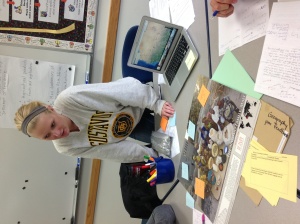Initially we were very overwhelmed with all the materials. There were so many different learning opportunities, many different ways to go, and over-all just a lot of material. The materials could have been used as a unit- therefore, our struggle was narrowing down what we wanted to teach. The standard for fourth grade talked nothing out of North America but we really wanted to use the posters from a variety of countries. If this were a unit it would have been fun to go into depth about each country.
We decided to choose three countries depicted that were pretty different from one another, and that were from different continents. This allowed for greater comparisons and showed more of the world.
We had students make their own journal to go with the lesson- this was a last minute addition; which worked in our favor. In the future we could make it a more structured journal that they could take home. The journal also served for evidence of student learning.
The google maps image of each location helped connect learning from environment and human interaction in these areas. It helped get the students thinking about how where someone lives might affect the food eaten. For example, Japan is surrounded by the ocean, therefore, they eat a lot of fresh fish. It’s not solely because they really like fish. Which tied nicely into the poster walk. The students came up with some really great observations and questions. We believe a lot of learning took place. The post-it notes from the gallery walk also allowed us to assess student learning, showing their initial ideas and beliefs. The Venn Diagrams also allowed for students to compare their table and one from around the world. It also, incidentally, served as more evidence of student learning.
If we were to teach this lesson again, we would some how incorporate the vocabulary. We would have liked to think of a creative way to present the words other than just reading the definitions. Some of our classmates had wanted to play games with the information and concepts. This would have been a great idea! Perhaps the next teacher candidates that look at teaching these concepts will come up with an engaging game.
Thank you all for having fun with us!
Kendra, Leah, Beth, and Steph

Initially we were very overwhelmed with all the materials. There were so many different learning opportunities, many different ways to go, and over-all just a lot of material. However, this was my favorite lesson of the two. It was very interesting and I felt my “students” were engaged and interested in the lesson. This is something I will use in my classroom when I have more time to go a little deeper.
I would have loved to have a whole unit of this in elementary school! I think it falls out of the traditional unit mold and is applicable to real experiences we have. You could do an interdisciplinary unit along this theme as well. GREAT lesson, well done to all!
This was such a wonderful lesson! Kendra taught our group and did a great job with keeping us engaged and excited to learn. I thought it was interesting with the different photos of the families from different countries. I thought that it was interesting with the prices of Germany vs. Africa. The Germany family did not look very happy in their photo and they had a surplus of food. The african family had more people and had less food than all the other families and they were very happy in their photos. Thank you for posting the “Where Am I Eating” link Leah. I think that the book that we read for the reading in common goes great with this lesson. It is important to be aware of the rest of the world and how they live.
I really, really, really enjoyed this lesson. I thought it was extremely interesting to see the difference in what is eaten in different places and learning why this may be the case. I loved the visuals that you used and they enhanced the lesson quite a bit. I also liked how you connected math in the lesson by having us add up and estimate what we spent on food each week. One thing I would love to see added to this lesson is to incorporate a mini-unit on agriculture and have the kids learn about agriculture and the types of food which are grown and made in their region. Great lesson that really gave us an opportunity to learn about other cultures and locations.
Like we said, there were so many great materials available for this until a challenge was narrowing down what we wanted to focus on for our mini lesson. These materials could have all been easily used to create an intensive week long unit! One of the resources was “Where Are We Eating” by Kelsey Timmermann. I read this book as a part of first year orientation and found it very interesting and eye opening. I think it is important to teach our student to become more globally aware and us as teachers can learn a lot from the book. Here is a link to his website if you are interested!
http://whereamiwearing.com/books/where-am-i-eating/